Company 'A' recently decided it wanted to send its customers a discount offer via email. Its marketing team sorted a mailing list, wrote the email copy, designed it, and got necessary approvals. Six weeks later, they were all set to go.
We live in an age where almost half of the internet users expect a website to load in two seconds. Today, news travels faster on social media than it does on TV channels. In 2022, roughly 333.2 billion emails were exchanged for prompt communication. This figure is expected to increase to 376.4 billion daily e-mails by 2025.
Using six weeks for promoting a discount offer pushes Company 'A' to the boundaries of irrelevance. You see, content takes time to develop and by the time, it hits the mailboxes of the recipients, the audience's needs and interests may have changed.
Companies need to follow an agile marketing approach that allows them to respond to the market changes and get content to potential customers quickly; campaigns and websites can be initiated in a launchpad form in a shorter span.
Table of content
Agility marketing: definition, methods and history
A tactical marketing approach it enables teams to identify and focus their collective efforts on high-value campaigns, complete them collaboratively, and measure and improve the results incrementally over some time.
Agile marketing does not mean agile teams do not fail at all. They may determine that a campaign is not valuable and should not be repeated. However, as long as it comes with lessons and helps execute more effective campaigns in the future, it is not considered a failure.
In a nutshell, agile marketing applies Agile Methodology to manage and improve how a marketing team gets work done.
Methods of agile marketing
There are two ways in which cross-functional marketers work in an agile manner for effective results:
1. Sprints
It refers to the amount of time given to the team to complete working on a campaign. Generally, a sprint lasts between 15 days and six weeks. For large-scale campaigns, sprints take place for a more extended period and are broken down into smaller prints to track progress.
2. Standup meetings
Each day, the team gets together for 15 minutes to track the campaign's progress and discuss the plan for the day ahead. The team lead also resolves any issues encountered previously to ensure the campaign is launched on time.
Project management tools such as Trello, Asana and ActiveCollab make it easy to maintain a record of each sprint and standup meeting.
History of agile marketing: how it all began
The formal history of Agile as a management approach dates back to 2001 when 17 software development leaders gathered for an offsite retreat in Utah to address the struggles of the software development community in the day.
Back in 1995, only 16% of development projects were deemed a success. The other 84% either went over-budget, delayed the delivery, or were simply cancelled. Yes, that is right!
The UK's NHS once abandoned an IT systems project after ten years after bleeding £10b in taxpayers' money. Reason being rapid technological advances and fast-changing customer preferences. The Agile Software Development Methodology put an end to wasteful resources.
In recent times, marketers have also encountered similar obstacles in managing modern marketing work. In June 2012, the agile manifesto for marketing was created to help marketers discover better ways to strategically and structurally make value for our customers.
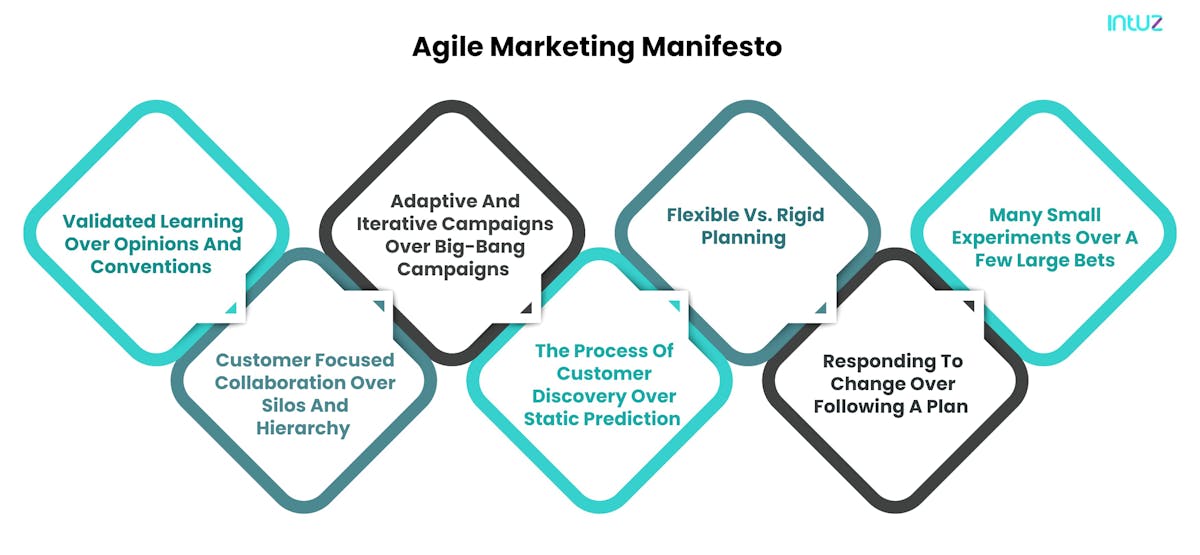
Today, 98% of companies have experienced success with an Agile campaign. Research shows that 53% of agile marketing teams can launch campaigns swiftly, and 51% can shift gears based on incoming feedback hassle-free.
Agile marketing vs Traditional marketing
Without a doubt — agility marketing is essential for companies to adopt to keep up with the fast-breaking world. It enables marketing teams to work fluidly and efficiently, without affecting the quality of work. But how is it different from traditional marketing? Let us find out in detail in this guide to agile marketing:
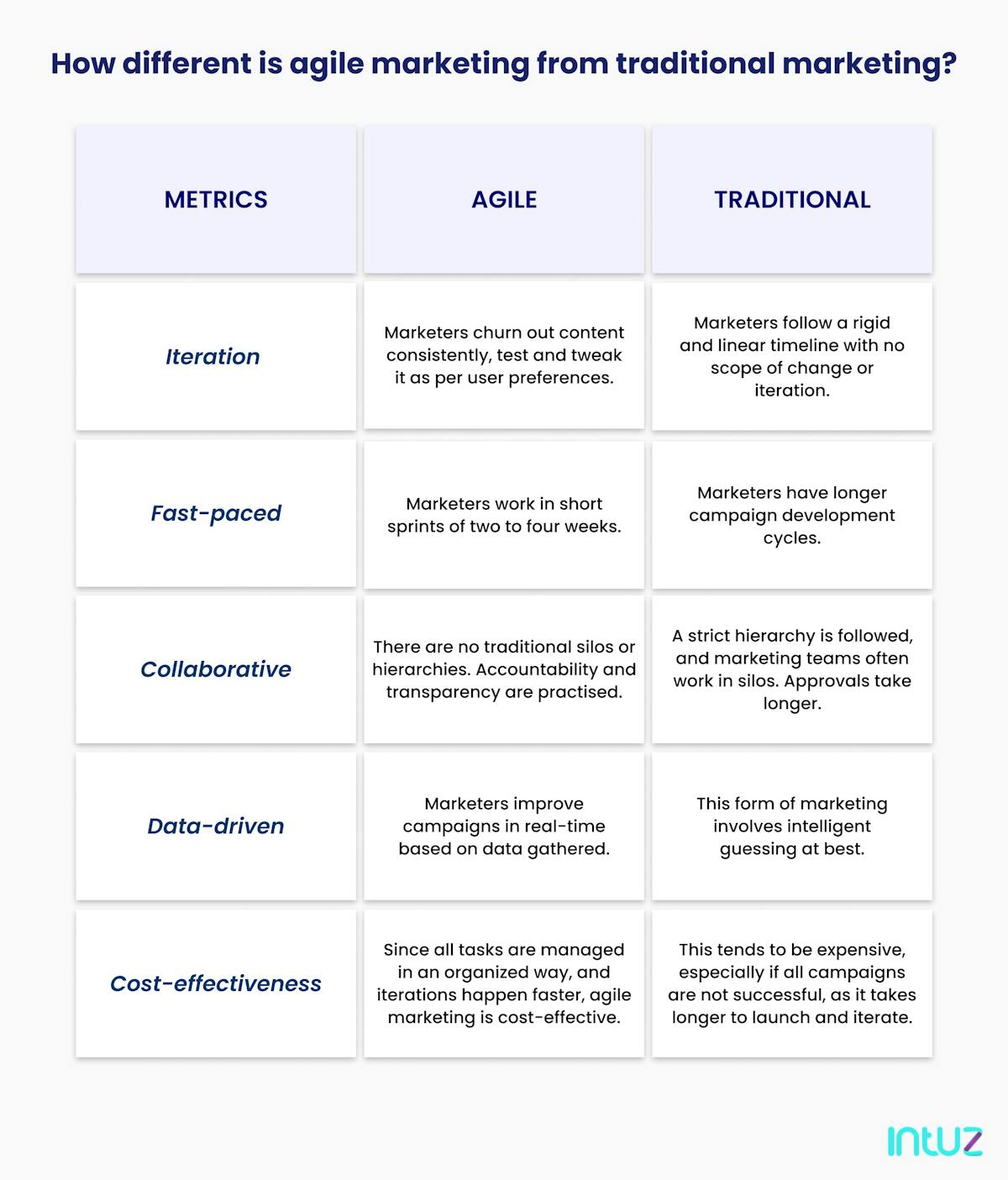
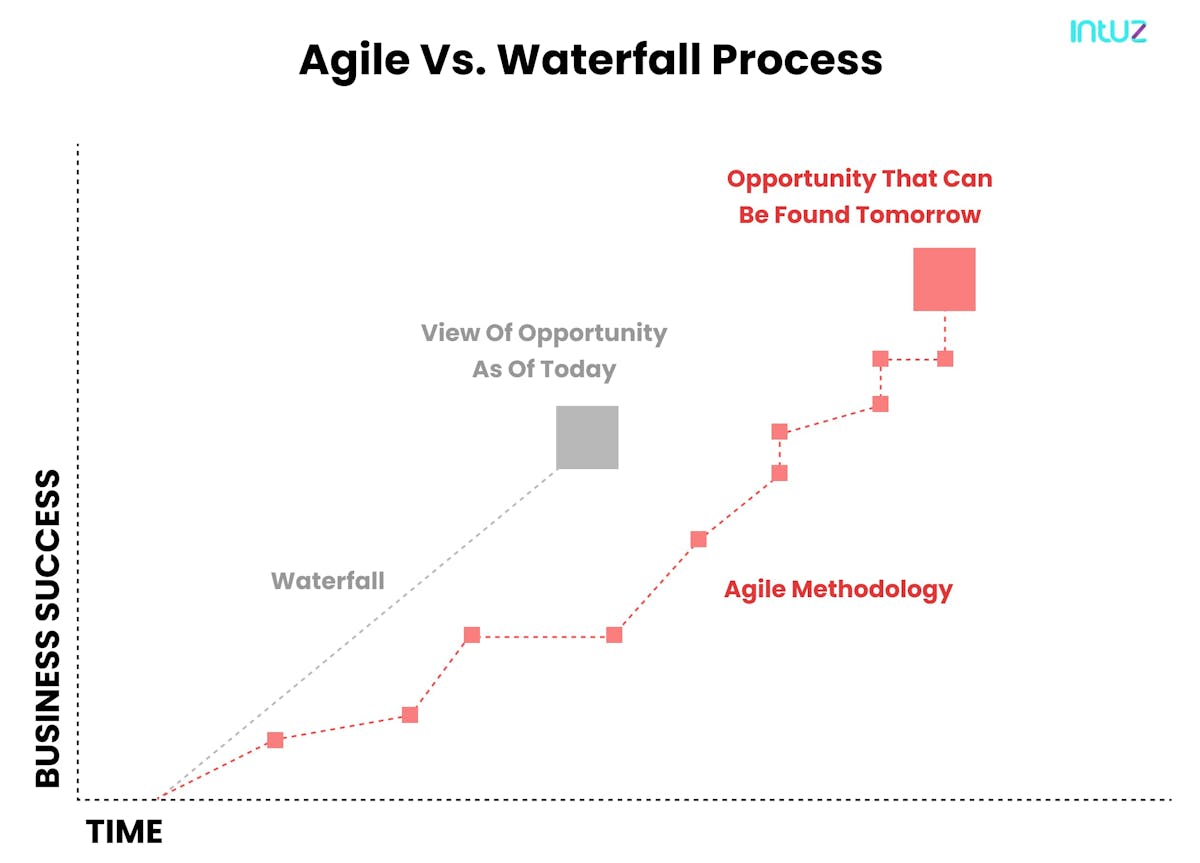
Six characteristics of an agile marketing team
The primary responsibility for any marketing department is to address the challenges faced within the field and build agile teams with skills, knowledge and vision needed to match the company's broader growth marketing plans.
Achieving the status of an agile team requires certain qualities, without which, they are more likely to make time-consuming mistakes in campaign strategy and execution. This section shines a light on six such characteristics:
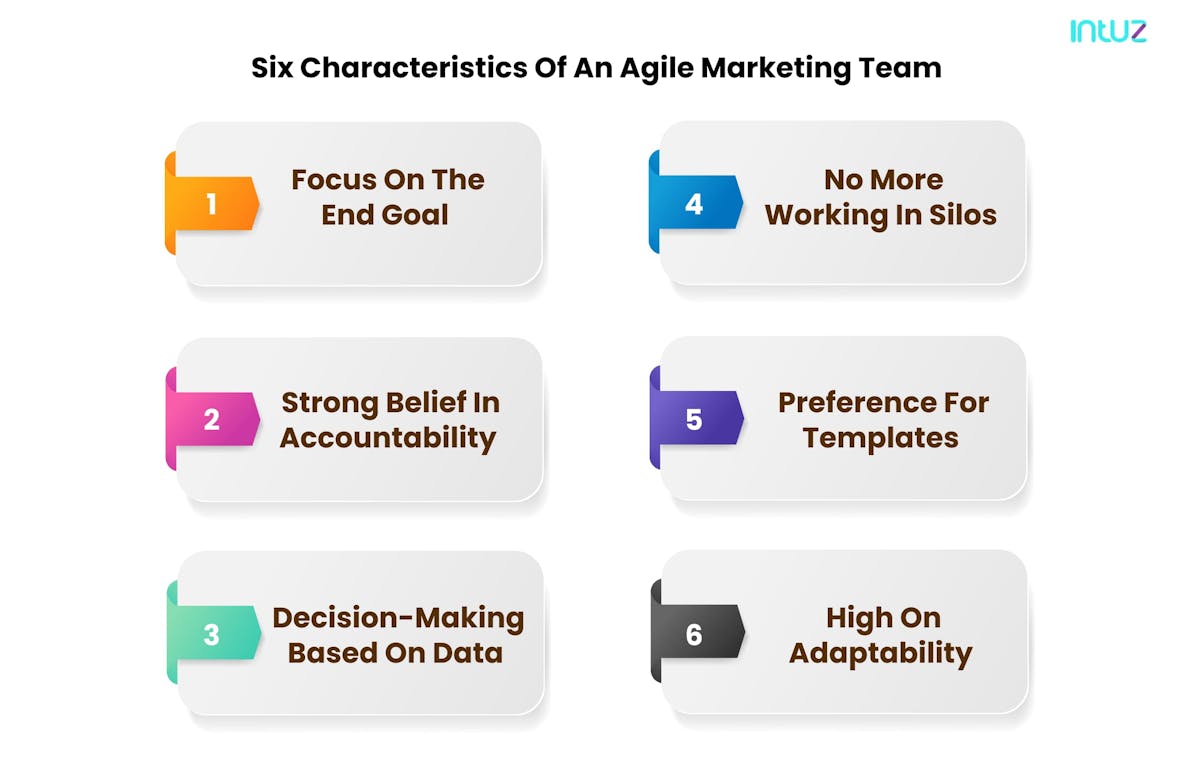
1. Focus on the end goal
They are focused on deliverables, not sprints. Sure, setting goals is essential, but the main aim is to get work done. The ends are specific, i.e., high-priority deliverables.
2. Strong belief in accountability
Deadlines, milestones and target dates are essential for tracking progress. But that is not it. Agile marketers leverage that to keep themselves accountable.
3. Decision-making based on data
Agile marketing teams do not believe in guesswork. They thrive on data and ensure that numbers form a big part of their campaign strategy, execution and post-launch. They understand there is too much information to manually handle, analyze and act upon.
4. No more working in silos
Great web and app marketing campaigns do not happen when writers, designers, social media specialists, SEO executives, email consultants and paid ad teams work in silos. They happen when everyone gets together on a single platform and work towards achieving a single goal.
5. Preference for templates
High-performance and agile marketers rely on creating templates that increase speed, capacity and competence for responding and acting on changing customer demands and marketplace dynamics. Practicality is the guiding north star, not tradition.
6. High on adaptability
According to a Forbes/CMG Partners study, 93% of CMOs employing Agile Methodology agree their speed to market for ideas, products and campaigns have improved considerably.
How agile marketing helps companies: 12 benefits
Companies that establish and empower high-performing agile marketers set the pace to do good work continuously. Here are a dozen benefits of following the "agile" approach:
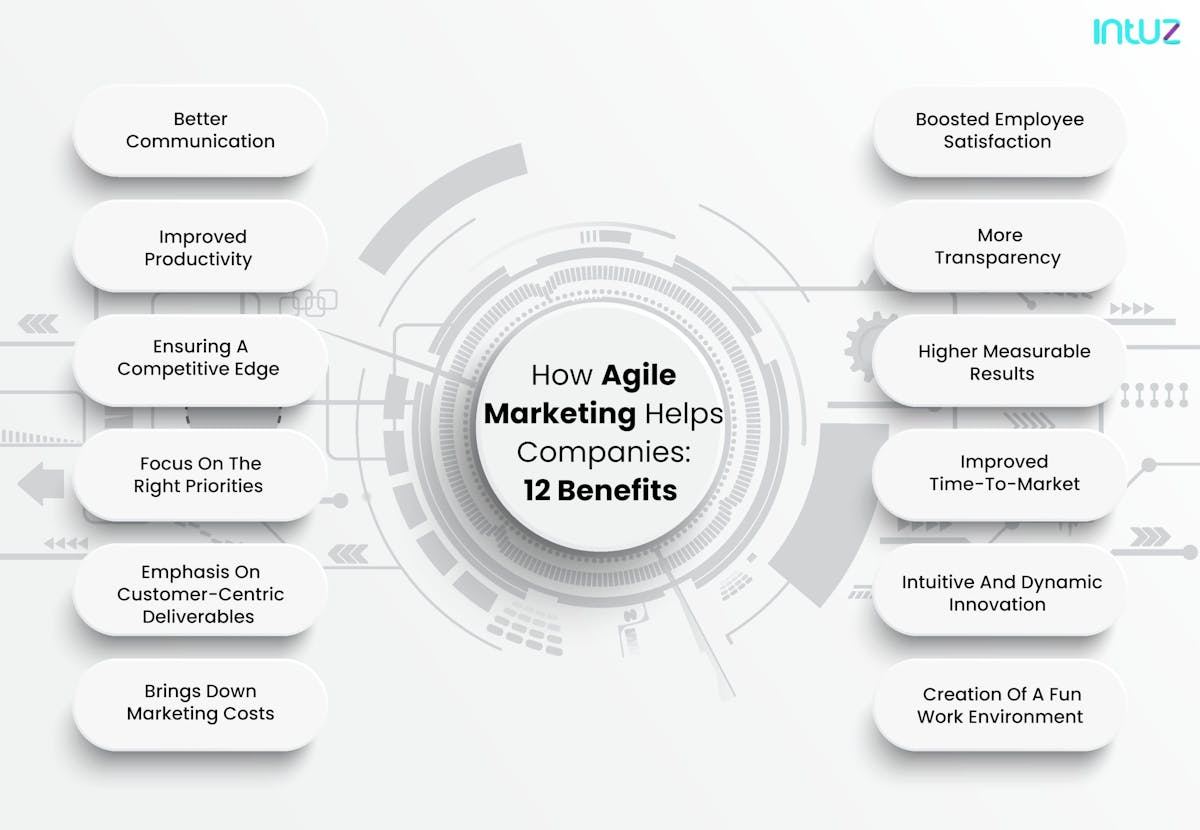
1. Better communication
This is one of the main reasons why companies adopt agile practices for their marketing team. Regular meetings and clear agendas ensure that every team member knows their role well and allows for any issues to be addressed on the spot.
Plus, many marketers encourage instant messaging platforms and other tools so that questions and requirements can be communicated quickly.
2. Improved productivity
Agile marketing helps teams become more productive because they know precisely what to focus on at each point in time. Rather than having a single long-view plan at the start of the campaign, agile teams divide their tasks and assign high priorities to the most critical tasks from a time-perspective.
This allows markers to focus on what needs to be done and get deliverables out faster. Agile also helps them tweak their methods as needed when problems are spotted so that the next work sprint happens without the same mistakes.
Besides, there are no silos anywhere as the entire marketing team has visibility on the goals and tasks, and no bottlenecks as information flows freely among everyone. This significantly improves overall efficiency and ensures the work gets delivered on time.
3. Ensuring a competitive edge
With agile marketing, teams can put out relevant content that is timely and in tune with what the customer wants. This puts the team ahead of competitors using a more traditional approach or not fully leveraging this methodology's power.
Moreover, agile practices are designed to be adaptable to team expansion or new sets of priorities, thus allowing the business to grow in tandem with industry trends.
4. Focus on the right priorities
With agile techniques, unnecessary steps and red tape no longer form part of the picture. Marketing teams are thus, always focusing on tasks that have the highest priority. In fact, they tend to review their backlog of tasks every day so that priorities can be adjusted as needed. This allows the team to be proactive, rather than reactive, and thus improves market results.
5. Emphasis on customer-centric deliverables
No matter how good a product, campaign or ad is, if it is not in line with what the target customer wants, it will not work. Agile techniques help marketing teams operate in a manner that keeps the customer's voice at the core of their efforts, whether that customer is an external client or an internal stakeholder. With unnecessary meetings and documentation out of the way, team members can keep their focus on making customers happy.
6. Brings down marketing costs
Traditional marketing was often slow to yield results, and even the results were often hard to quantify. Now, modern digital marketing tools allow for data insights to be obtained with a few clicks.
At the same time, agile techniques help marketing teams manage more than one campaign without reducing their effectiveness or causing too much chaos.
Plus, because the content created is now more timely and in tune with what customers want, there is no need to invest in multiple inbound marketing solutions in the hope of more results. This makes marketing less expensive and helps to improve bottom-line results.
7. Boosted employee satisfaction
Agile marketers tend to be happier at their jobs than average. Reasons for this include clarity of one's role, assigning tasks based on one's skill sets, regular communication with the rest of the team to address problem areas, quicker results obtained due to a fast-paced approach, etc. The happier they are with the tasks-in-hand and their team members, the more productive they will be, which means higher-quality output.
8. More transparency
Agile marketing techniques provide clear insights into what is happening on a day-to-day basis. With regular meetings, stakeholders and managers can give on-the-spot feedback, which can be incorporated at once to improve the deliverables.
This also allows for fellow marketers to talk openly about their contributions, be acknowledged for their hard work and ask for assistance as needed. Transparency, moreover, also reflects in the marketing team providing honest services for its customers.
9. Higher measurable results
Agile marketing is grounded in the principles of measuring and staying accountable. Each effort is calculated according to definite metrics in this agile process.
The marketing team can rapidly identify what is working and what is not and make adjustments accordingly — without wasting too much time guessing. This also helps them deliver tangible progress updates to senior management.
10. Improved time-to-market
It might be a cliche, but in the marketing world, time is money. If a company does not get there first with an idea, someone else will. Agile techniques allow for procedural infrastructure to be revamped to enable the rapid movement of a product from ideation to delivery.
They also help the marketing team adapt more quickly to changes or user feedback and respond more rapidly than the competition.
11. Intuitive and dynamic innovation
With its emphasis on rapid testing and prompt responses, the Agile Methodology helps marketing teams discover new insights much faster. This allows marketing efforts to be driven by hard data rather than just guesses.
Besides, by moving quickly and adopting a fail-fast mindset, agile marketing teams can implement innovative ideas more efficiently and thus benefit sooner from better results.
12. Creation of a fun work environment
The Agile Methodology fosters creating an open work environment where everyone can discuss project-related updates, challenges and opportunities while also getting to know their teammates better.
Constant collaboration allows marketing teams to understand what others need and work through any obstacles. In contrast, regular meetings enable problem areas to be brainstormed and wins to be celebrated collectively.
Better team camaraderie boosts productivity, employee morale and creates a more accountable and empathetic team environment.
Intuz’s Agile App Development Methodology
Discover hereSeven agile marketing techniques to deliver projects effectively
Agile is virtually all about communication, collaboration and iteration to execute quick responses to market challenges and opportunities.
Agile methodologies have established themselves as the preferred way to reduce time-to-market for new products, minimize waste and maximize smart results.
While agile has traditionally been a feature of software companies, the principles are applicable everywhere. Here are seven agile techniques you can apply to your marketing strategy to stay ahead of your competition:
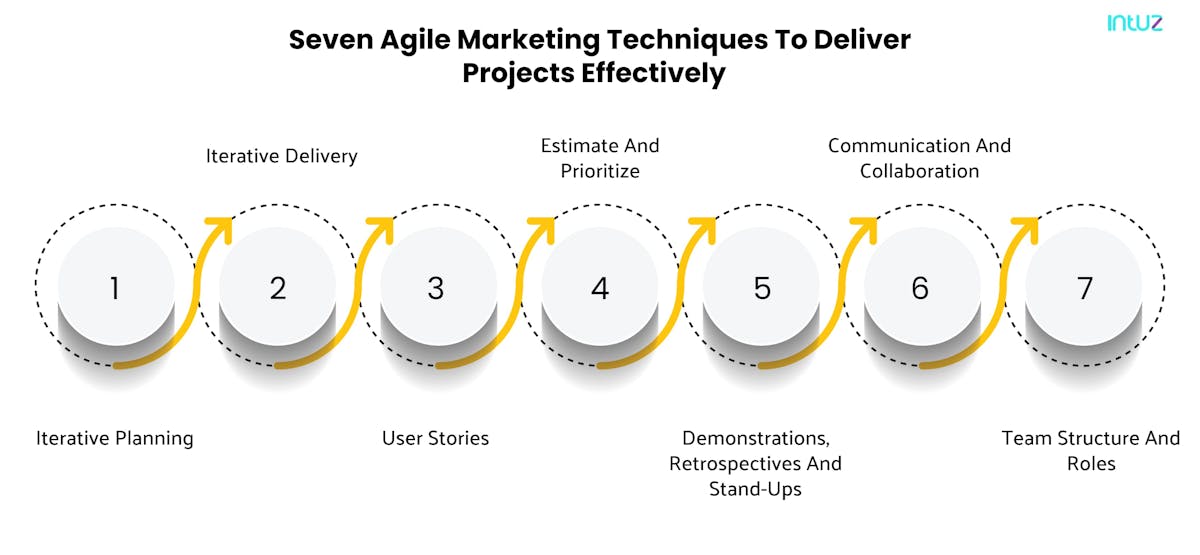
1. Iterative planning
Agile is all about flexibility. This means that rather than having one single blueprint at the start of the campaign when understanding the results is lowest, planning happens as inspections are made, and opportunities for improvement are identified.
This allows the project to grow in its directions, mainly as user feedback and stakeholder inputs come in.
By incorporating interactive planning into a marketing campaign, the marketing team can quickly modify or drop elements that are not working, amplify the aspects that are doing well, explore new avenues as new trends and preferences come to light and so on.
Agile techniques can help you plan more efficiently for an upcoming campaign launch by reviewing the priority levels of associated activities as you understand the requirements better.
2. Iterative delivery
Just like with planning, agile techniques take an iterative approach to delivery that focuses on completing individual tasks and features so that the project can go live as soon as possible as a Minimum Viable Product (MVP) or a lightweight deliverable.
There are several different ways this can be managed. A popular technique is Scrum, where work is completed in short sprints that typically spread over two weeks. At the end of each sprint, the pre-assigned deliverables are presented to the stakeholders to minimize wasted costs, speed up the feedback loop and establish greater control over the budget.
Another technique is Kanban, the team uses a priority list of tasks or 'backlog' to manage the activity, to complete the most critical tasks first and resolve bottlenecks at an early stage. You can also create a hybrid model adapted to your specific needs by taking features of both Scrum and Kanban.
3. User stories
User stories are not exclusive to an agile approach, but they align with the core principles of agile and can help maximize the value delivered through each project.
A user story typically takes the form of "As [user], I want to [task], so that [motivation]". This approach ensures that project requirements are being met in direct reference to what the user needs.
It also helps to communicate these requirements to the entire team in an easily understandable and memorable format. However, what is more important is to convey project requirements clearly and concretely even if you do not use this exact format.
The INVEST mnemonic is a useful tool here - it stands for Independent, Negotiable, Valuable, Estimable, Small and Testable. Requirements that fulfil these criteria are good to go, regardless of how small or large their scope is.
4. Estimate and prioritize
Breaking down requirements into clearly defined segments based on the user story technique will help you accurately assess the amount of effort needed to complete each task along with any associated activities.
Agile also advocates using techniques such as affinity estimation and planning poker to safeguard the accuracy of your estimates. The next step after the assessment is to prioritize each of the user stories according to business value.
How you define this value will depend on your business goals. However, be sure to keep reviewing your priority list as the project progresses, as iterative delivery calls for.
This way, you can always have an up-to-date backlog of tasks on hand so that you know the most critical tasks are being worked upon at any point in time. It also enables quick amendments to this backlog based on any feedback you receive.
5. Demonstrations, retrospectives and standups
An essential part of the Agile Methodology is to provide team members and stakeholders with the opportunity to assess how the project is regularly going. The Scrum framework covers these under demonstrations, retrospectives and standups. Let us examine each of these in turn:
- Demonstrations:
These happen after every sprint and include the leading project team and other stakeholders who may not be directly involved in the day-to-day project progress. Demonstrations thus offer a chance to get feedback from these stakeholders, which can act as a critical project check-point and be used to adjust subsequent prioritization and delivery activities as needed. - Retrospectives:
These also happen at the end of every sprint, but focus on letting the project team members reflect on their performance rather than project deliverables. This helps them identify what is working well along with how they can improve their performance. - Standups:
These act as a supplement to formal demonstrations and retrospectives. They occur every day and allow team members to talk about what they accomplished that day, what they plan to work on the next day and any difficulties that might need addressing. This helps keep visibility levels high on every aspect of the project and keeps the momentum going.
6. Communication and collaboration
To truly unlock the power of agile techniques in your organization, you will need to implement a cultural shift across your teams that focuses on effective collaboration.
This is essential, as it provides you with necessary insights on keeping activities aligned with your business goals and ensures that the solutions you are developing address real-world needs. That is the whole point of this methodology.
Therefore, to accomplish this, you will need to assess how your marketers currently communicate and then deploy training activities to understand and execute better communication practices.
You can add instant messaging applications and agile project management tools into your workflow mix to foster more productive communication. Another option is to introduce testing activities to get user feedback even at the early stages of your project.
7. Team structure and roles
Agile frameworks often recommend limiting the project team size to between three and six members. This helps to maintain focus and velocity and allows the campaign to be delivered as efficiently as possible. However, in marketing, the number can fall between five and ten.
The core team can include anyone involved in the day-to-day project deliverables, from salespeople to developers to content strategists. There are several additional functions related to the core team that you might wish to introduce.
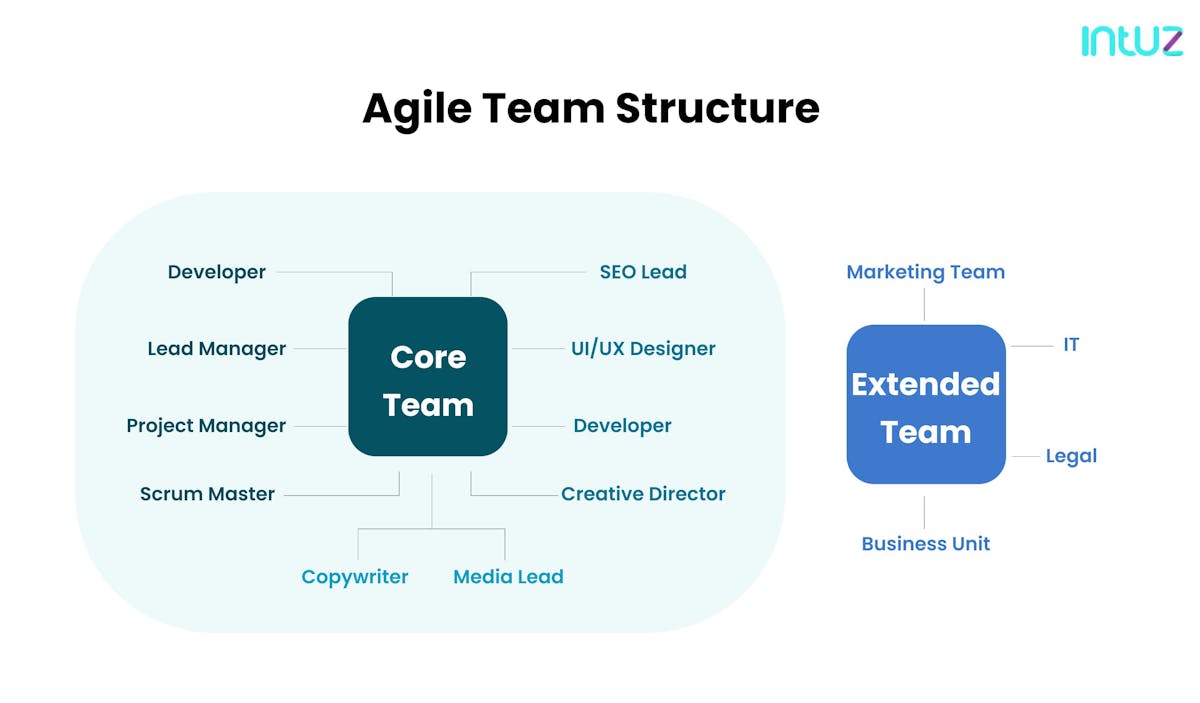
Some of these can be taken up by core team members themselves, as long as they are well aware of the responsibilities and can manage them in addition to their regular work:
- Product owner:
This role represents the voice of the user. The product owner's job is to ensure that the project's outcome delivers the most possible value to the end-user and maintain this end-user focus throughout the project. - Scrum master:
This is particularly important for a sprint-based approach to project execution. The Scrum master helps to optimize team performance by addressing the obstacles discussed in the daily standup meetings and by working with other stakeholders to support the core team members as needed.
It is important to remember that the presence of these two roles does not imply the micro-management of the core team. The goal should be to build agile teams empowered to make their own decisions while keeping up regular communication and collaboration to keep the campaign in line with your business objectives.
Before you commence the agile transformation journey for your marketing team, you will need to have a clearly defined strategy in place. Things that will help you do this include conducting an
as-in audit, identifying the most appropriate agile approach for your business, designing a training plan, implementing a trial run and then rolling it out across your company. And of course, be sure to keep monitoring and adapting as you progress and learn new things.
An overview of the agile framework
The Agile Methodology promotes a framework where marketing development is an ongoing strategy that monitors, learns and improves. Here is a quick outline of the framework:
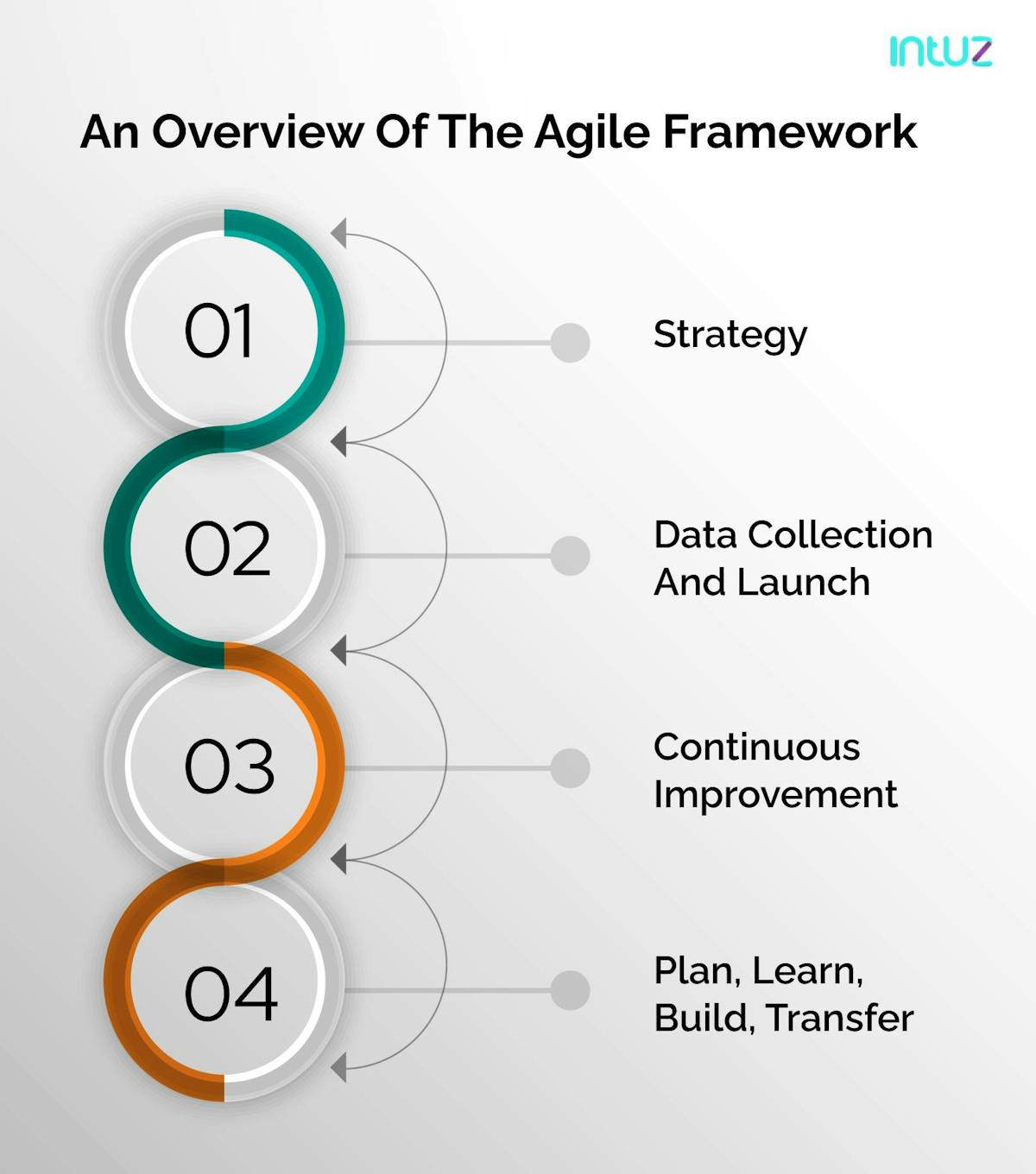
1. Strategy
The first step is to set goals for your new campaign based on an audit of the currently used tactics. Examine what kind of content you are putting out, what value your audience is getting from it and how your audience interacts with it.
Then, come up with a wishlist of items that can deliver 80% of your marketing results, with 20% of the effort. This will call for you to closely examine the value-add for each of your current activities and prioritize only the must-haves.
2. Data collection and launch
If you want to take your new campaign, live as soon as possible, you will need to quickly gather data about the current market scenario and how your past campaigns have been doing. There are several analytics tools you can invest in that will help you with this.
Then, prepare and launch a test or demo version of your project so that you can start seeing results. Agile promotes rapid product releases and a fail-fast attitude where there is no scope of red tape or unnecessary delays.
3. Continuous improvement
Keep monitoring what your test campaign is doing. Compare the numbers with the goals you had fixed during the strategy stage. Identify any shortfalls and see how you can rectify them.
4. Plan, learn, build, transfer
The Agile Methodology calls for iterative development, where your marketing team follows a continuous cycle of four steps:
- Plan:
To make the most of your work sprints, plan a schedule. Try to cross off as many items from your wishlist as possible. - Build:
Complete the tasks on your agenda after allocating the right roles to the right team members. Incorporate ways of collecting data on your performance metrics along the way. - Learn:
Keep reviewing your data from your tests to see what is working and what is not. - Transfer:
Share your learnings with the entire team to be on the same page and collectively decide what changes need to be made in the next iteration.
Agile marketing process: A step-by-step explanation
While many marketers have hopped onto the growth hacking bandwagon, a more sustainable way to achieve results is by consistently working to deliver the right product to the right customer at the right time.
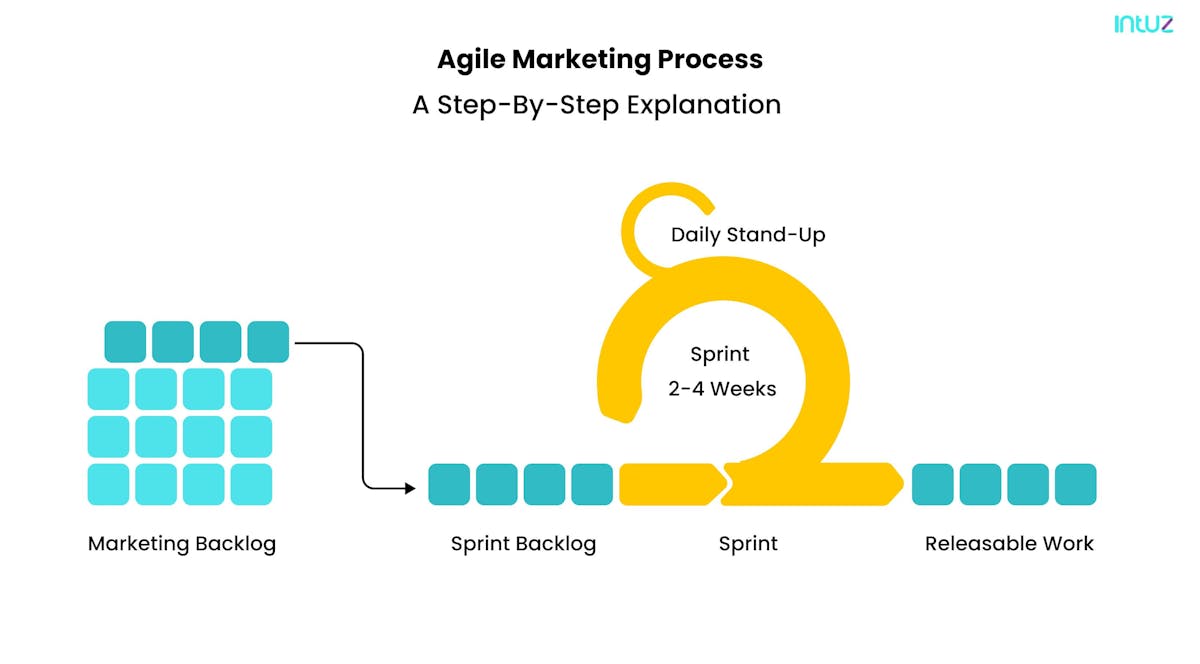
The agile framework helps the marketing team develop a systematic approach to each campaign. Here is a step-by-step breakdown of this approach:
1. Choose the metrics that matter
Each component of your marketing campaign needs to be measurable, which means that you need to pick the metrics and the benchmarks that will show you whether you are going in the right direction. Remember: data is everything in modern decision-making.
An often-used concept is AARRR metrics, developed by David McClure, where AARRR stands for Acquisition, Activation, Retention, Referral, Revenue.
Here are a few tips on how to implement agile marketing via these metrics:
a. Measure everything you can from the start
Invest in a useful analytics tool that will help collect and study your data. The more you measure, the more data-driven your decisions will be and the stronger your test hypotheses will be.
b. Add specific metrics as needed
If you want to focus on any specific steps in your marketing funnel, you can add more elements to measure those steps. If you are working closely with the sales teams, you can also ensure an agile sales management by setting metrics in place.
c. Focus on Activation
This can be a difficult metric to identify and measure correctly, as activation is about an 'aha' moment in the consumer's mind. There is often no one element that leads to this moment. So, you have to set a potential 'aha' moment in the campaign.
To define activation, the marketing team needs to identify common patterns and behavioural traits among returning customers, which calls for a detailed analysis of what those customers did on their first website visit/interaction. Analytics tools can help in this regard by identifying links between user actions and active usage.
2. Set your goals and pace
The first step in any campaign is to set your goals. Ideally, you should focus on only one or two priorities at the same time — trying to manage too many goals at once will not only be hectic but also impact your overall effectiveness.
The next step is to plan out your work sprints and the goals for each. How long each sprint will depend on your team size and the kind of project you have on hand, but about two weeks is usually sufficient time.
Be sure to plan a retrospective after each sprint to assess how things went and where to improve. It also helps to have daily standup meets where your marketing team discusses how things are going, and what roadblocks they encounter.
3. Build a growth backlog
You and your team need to have a backlog of hypotheses in place for testing. To develop these hypotheses, analyze your data for useful insights or look at related articles for inspiration. Add the ideas you gather to the backlog and then assign each a priority based on how soon it needs to be addressed. This will help you stay on top of all industry trends and consumer preferences.
4. Choose what to test next
To optimize your time and maximize the results you get from each sprint, each hypothesis needs to be evaluated before building or testing anything. An excellent way to do this is by using the ICE framework, where ICE stands for Impact, Confidence and Ease of implementation.
Assign each hypothesis a score between 1 and 5 for each of these three metrics, where 1 is the lowest and 5 is the highest. The hypotheses with the highest cumulative scores can be prioritized for your next sprint.
It is essential to remember that your team needs to focus on these predetermined priorities, even if new hypotheses come up during work. Deviating will interrupt your workflow and reduce your team's effectiveness.
5. Test and analyze
Once you start working with each hypothesis, keep collecting data on how it is doing. There are different tools available to help you test the data in different ways, such as A/B testing, visual monitoring, real user testing, and so on. This is a critical step in executing a campaign in time and effectively.
6. Repeat
At the end of each sprint, have a retrospective where everyone discusses what went well and what didn't and how to proceed going forward.
Retrospectives are crucial to removing learning barriers, encouraging everyone's contributions and helping the marketing team become more efficient. This way, your team will become more agile with each sprint and keep discovering newer and stronger insights.
Essential concepts in the agile framework
To help your marketing team achieve the continuous improvement that agile techniques promise to deliver, here are the key concepts to keep in mind:
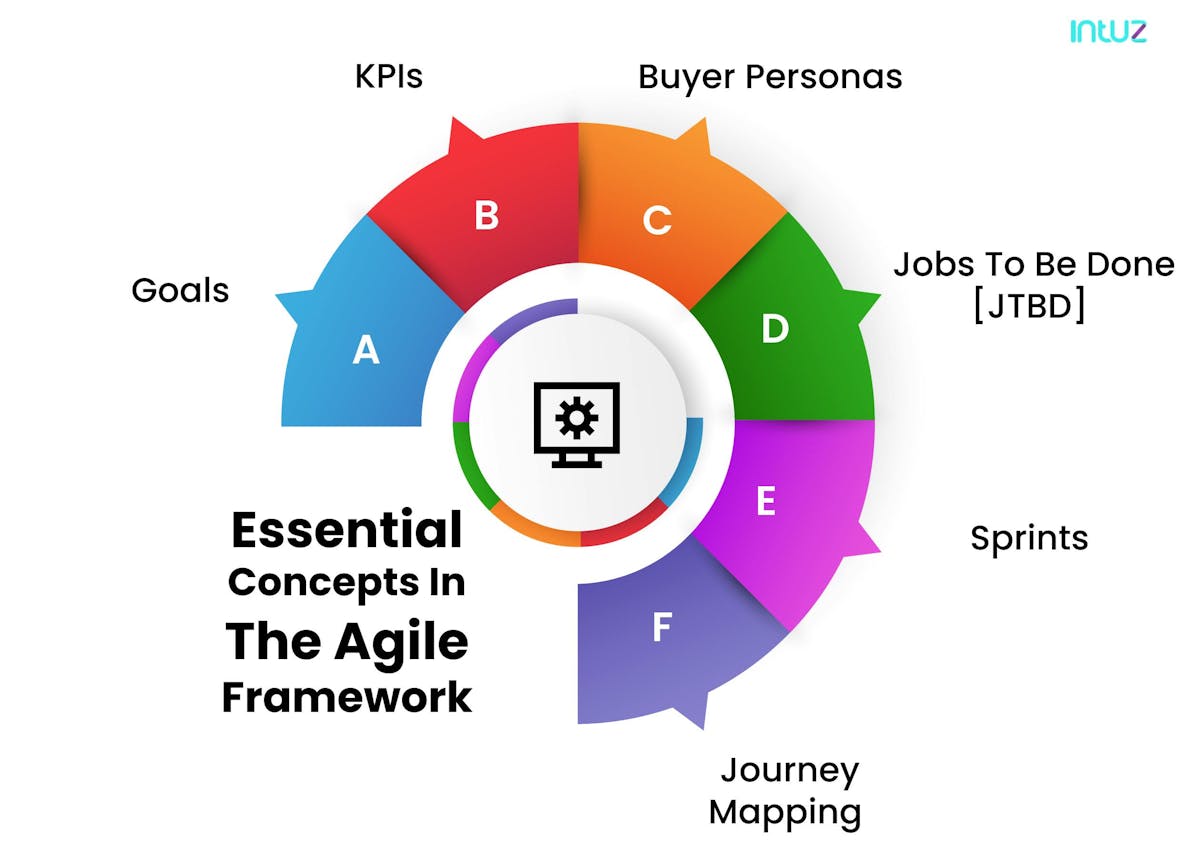
a. Goals
The agile framework emphasizes SMART goals, which are specific, measurable, achievable, relevant and timely. The goals, moreover, need to be revisited in subsequent iterations to see whether priorities have changed.
b. KPIs
Key performance indicators need to be established so that the marketing team knows what metrics to work with and what needs to be adjusted.
c. Buyer personas
Having concrete descriptions of your target audience members will help you develop the content and features that will attract them the most. Building buyer personas will help your marketers create campaigns best suited to them.
d. Jobs to be done [JTBD]
This is the list of to-dos that your marketing team will prepare based on the regular meetings you have, including wishlist items you might need to save for a future sprint.
e. Sprints
These are quick, short bursts of team activity with a predefined set of goals. The aim is to complete all of the goals on the list as efficiently as possible. A single sprint is usually 15 days to 6 weeks long. You can also have a longer sprint, comprising shorter sprints and daily standups.
f. Journey mapping
It is vital to focus on your long-term marketing goals even as you work through your short-term sprint goals. Mapping out an overall marketing strategy helps to keep things in perspective and helps act accordingly in time.
Is your app visible amongst 3.55 Million apps in the Apple Store yet? Explore how can you ensure that.
Get startedUse cases for agile marketing
The Agile Methodology can be applied to multiple marketing aspects to accelerate progress and keep the marketers' focus on the right priorities. Here you go:
1. Website creation
The Agile Methodology is particularly well-suited to website creation projects . It starts with assessing the current website for usability, SEO and content usefulness, and then building a strategy based on user persona and the buying journey.
When planning for a sprint for a website project, create a wish list focusing on goals that will achieve 80% of results with 20% of the effort. The other tasks can be set aside for future priorities — what is essential in an agile website creation campaign is to get an initial launchpad site out there as soon as possible.
Subsequently, you can conduct tests to see how different elements of your site are working and then make modifications along the way, in the spirit of continuous improvement and achieving your agile marketing strategies.
2. Marketing campaigns
Campaign workflows are also ideally suited to an agile approach. Rather than having one set workflow for the entire duration of your campaign, you can keep testing different workflow elements to see what is working better and what could be improved. Often, even simple things such as email subject lines, CTAs or form fields can make a big difference if tweaked.
Examples of successful agile marketing campaigns
Agile methodologies are not just great in theory. Multiple companies have incorporated agile techniques into their marketing teams and seen considerable success. Here are some prominent examples of taking ideas from:
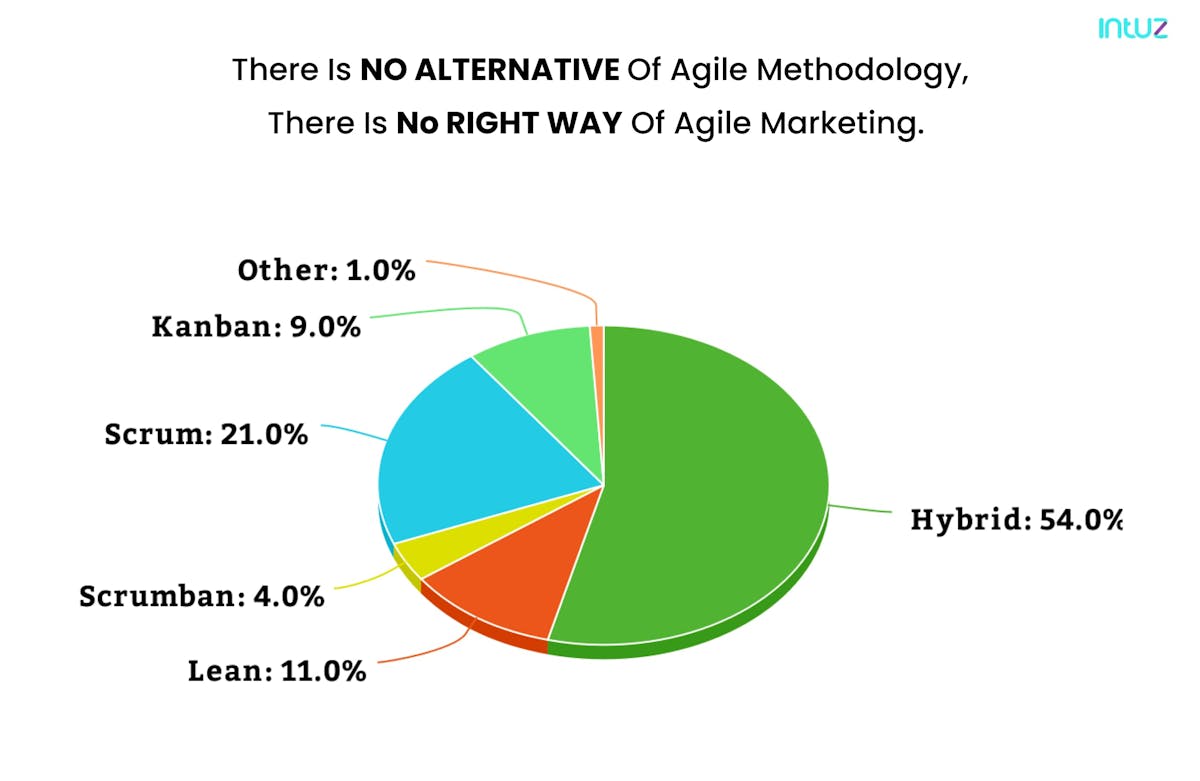
1. SEMRush
This software company has implemented agile and comes as close to a fully flat organizational structure as possible, which allows each team to be fully empowered. They follow the Scrum approach to workflows and have daily standup meetings to ensure that everyone is staying on track, and all campaigns are being carried out as per plan.
Scrum also allows them to experiment rapidly with marketing ideas and keep learning on an ongoing basis — and these small-scale tests have helped them acquire 500,000 users in just eight months. That is an achievement!
2. Northern Arizona University
Originally a four-person team outsourcing content creation to freelancers, they discovered agile marketing and have never looked back. Today, they organize their work into two-week sprints and have teamed up with IT to create one in-house design hub.
This new approach lets them break activities down into smaller parts and then assign them to available team members based on the skill sets needed.
Their sprint tasks have almost a 95% completion rate, while content creation increased by 400% in their first year as an agile marketing team. There is no way to fail with the "agile" approach!
3. Mozilla
This company has been implementing Agile principles for a while now. While they used to struggle with silos and a lack of objective measures to prioritize their work, they redesigned the organization to improve the quality and frequency.
Teams are organized based on core KPIs, and they also employ user stories to create faster and better solutions. The Mozilla team stays on track pretty much all the time!
4. Deakin University
Deluged by a series of tight deadlines, Deakin University's marketing team turned to the Agile Methodology for a rapid solution. They brought together project-based teams and divided each task into manageable chunks, which helped them meet their deadlines.
The entire university has opted for agile marketing adoption. Their productivity has gone up thanks to empowered staff members and more real-time communication.
5. Dell
Everyone in Dell's global marketing team was doing things a little differently across the product lines and portfolios, which led to disconnect points and unclear processes across SEO, lead generation, field marketing and so on.
The team thus employed agile principles and combined it with an inbound marketing approach. Over seven months, they created a well-connected global marketing team that operates on one-month sprints and uses Agile Methodology everywhere.
Summing up
The marketing landscape is changing rapidly. As consumer expectations rise, marketing technology gets more sophisticated, and the number of promotional channels increases, marketers are under immense pressure to let go of tried-and-tested ways that do not work anymore and instead discover agile techniques that deliver hardcore results faster.
Fortunately, agile marketing holds the key to ensuring marketing works even in the most volatile of climates. Of course, if you plan to follow this approach, you must remember it could take you some time to get used to having sprints, standups and milestones.
Looking to implement an agile methodology in your company's marketing strategy? Our experts are here to help! Book a free consultation with us today and learn how to optimize your marketing approach with agile methodologies. Contact us at getstarted@intuz.com to schedule your consultation now!




